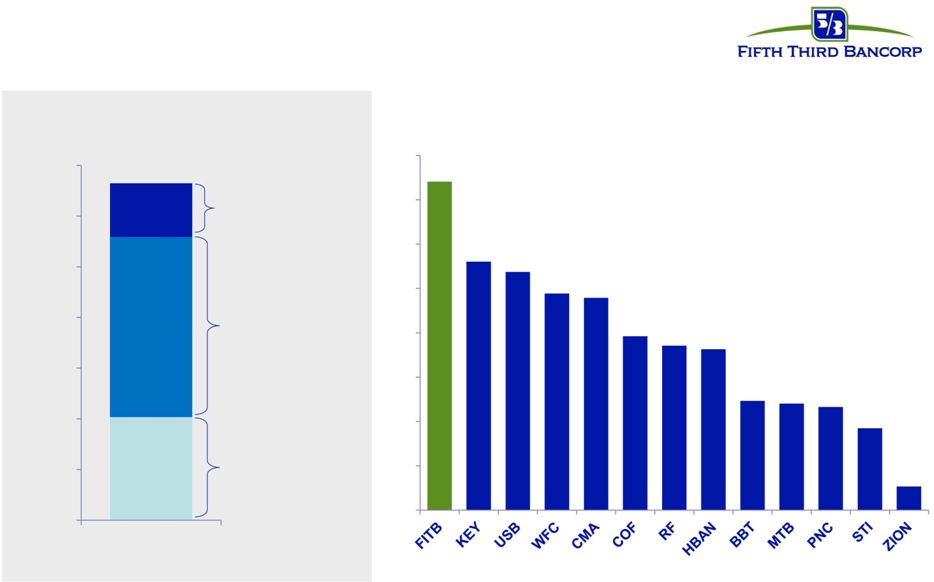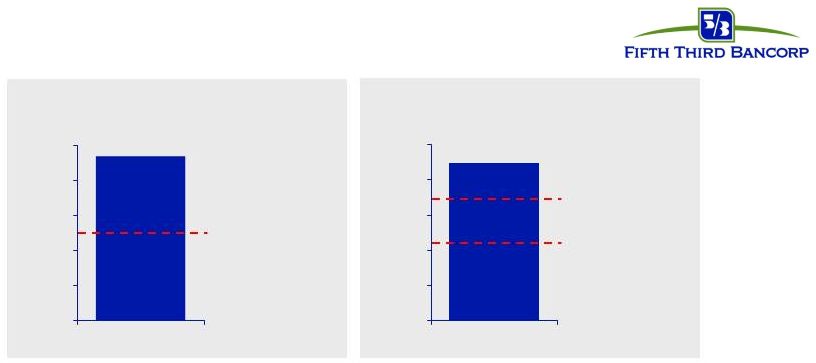Attached files
| file | filename |
|---|---|
| 8-K - FORM 8-K - FIFTH THIRD BANCORP | d711292d8k.htm |
 Annual Meeting of
Shareholders April 15, 2014
Please refer to earnings release dated January 23, 2014
and 10-K dated February 24, 2014 for further information,
including full results reported on a U.S. GAAP basis.
Exhibit 99.1
Fifth Third Bank | All Rights Reserved
© |
 2
Fifth Third Bank | All Rights Reserved
©
2013: A record year
Return on avg. assets
Net income to common ($MM)
Generated highest level of net
income in Company’s history
Steadily improving profitability
providing positive momentum
Net charge-off ratio
Problem assets at lowest
levels in five years
Tier
1
common
ratio
ALLL / NPLs
Coverage levels among
highest in the industry
Strong and stable capital ratios
1
2
Total payout ratio
Net payouts to shareholders
of
$1.3B
in
2013
2
$511
$503
$1,094
$1,541
$1,799
2009
2010
2011
2012
2013
6%
6%
23%
63%
74%
31%
39%
11%
74%
2009
2010
2011
2012
2013
0.6%
0.7%
1.2%
1.3%
1.5%
2009
2010
2011
2012
2013
7.0%
7.5%
9.4%
9.5%
9.4%
2009
2010
2011
2012
2013
3.20%
3.02%
1.49%
0.85%
0.58%
2009
2010
2011
2012
2013
127%
179%
157%
180%
211%
2009
2010
2011
2012
2013
1
2013 is net of the issuance of shares valued at $398MM related to the Series G
preferred stock conversion on July 1, 2013. 2012 and 2013 include repurchases of shares in the amount of after-tax
gains on the sale of Vantiv shares.
Non-GAAP measure; see Reg. G reconciliation in appendix; presented under current
U.S. capital regulations 1 |
 3
Strong capital return to shareholders
2013 total payout yield (regional peers)
Increased common stock dividend 31%
and repurchased 3% of outstanding common stock
$1.3 billion in capital returned to
common shareholders
$710MM common
stock repurchases
(net of $398MM
shares issued
related to Series G
conversion)
$407MM common
dividends declared
$212MM common
stock repurchases
utilizing AT Vantiv
gains
$0
$200
$400
$600
$800
$1,000
$1,200
$1,400
2013 Net Payouts
($MM)
7.4%
5.6%
5.4%
4.9%
4.8%
3.9%
3.7%
3.6%
2.5%
2.4%
2.3%
1.8%
0.5%
0%
1%
2%
3%
4%
5%
6%
7%
8%
Total
payout
yield
equals
dividend
yield
plus
shares
repurchased
($)
/
reported
market
cap
at
12/31/13.
For
FITB,
shares
repurchased
($)
is
net
of
the
issuance
of
shares
valued at $398MM related to the Series G preferred stock conversion on July 1, 2013.
Fifth Third Bank | All Rights Reserved
© |
 4
Capital management –
core focus
Current capital requirements
Tier
1
common
equity
ratio
5% CCAR
supervisory
reference
minimum
Future capital requirements
Basel
III
Tier
1
common
equity ratio
4.5% 2015
Basel III
minimum
7.0% 2015
Basel III
minimum
9.4%
0%
2%
4%
6%
8%
10%
2013
9.0%
0%
2%
4%
6%
8%
10%
2013
•
2014 CCAR plan not objected to by Federal Reserve Board
•
Included the following potential actions for the period 2Q14-1Q15, subject
to Board approval and other factors: –
The potential increase in the quarterly common stock dividend to $0.13
per share
–
The potential repurchase of common shares in an amount up to
$669MM
–
The additional ability to repurchase shares in the amount of any after-
tax gains from the sale of Vantiv, Inc. stock, if realized
•
2014 CCAR plan designed to maintain regulatory common equity capital
ratios generally at current levels Fifth Third Bank | All Rights Reserved
©
1
1
1
Non-GAAP measure; See Reg. G reconciliation in appendix. Presented under current U.S.
capital regulations. The pro forma Basel III Tier I common equity ratio is
management’s estimate based upon its current interpretation of recent prospective
regulatory capital requirements approved in July 2013.
|
 5
2013 total return
(price appreciation plus dividends)
Source: Bloomberg, 12/31/12-12/31/13
Market recognizing Fifth Third’s progress
FITB +42%
S&P Banks Index +36%
S&P 500 Index +32%
0%
5%
10%
15%
20%
25%
30%
35%
40%
45%
Fifth Third Bank | All Rights Reserved
© |
 6
2013 key themes
•
Solid returns and healthy balance sheet with strong growth potential
•
Continued long history of disciplined expense management
•
Executed on strategic plans:
–
Enhancing scale and scope of Commercial Bank
–
Redesign of Consumer Bank for long term profitability
–
Growing wealth management and brokerage services
•
Balanced capital management supporting growth and shareholder returns
Fifth Third Bank | All Rights Reserved
© |
 7
Looking at banking differently
Together we’ve donated a total of
to Stand Up to Cancer
$1,126,350
Fifth Third Bank | All Rights Reserved
©
Homeowner Reemployment Program
•
First in the industry to offer job search
assistance to unemployed mortgage
borrowers
•
30% - 40% reemployed after 6 months •
Directing donations toward cancer
research with every qualifying purchase
made using a Fifth Third SU2C debit or
credit card |
 8
Accolades
First and only firm recognized
as “Five STAR Servicer”
March 26, 2014
Second time recognized and
one of 32 companies chosen
April 3, 2013
Power Partner award
One of only 18 companies chosen
November 14, 2013
Best Overall,
Best Visibility of Major Fees, and
Best Clarity of Fee Information
August 2013
Significant national and local recognition across diverse areas
Business Practices •
Employment •
Green Initiatives •
Customer Service •
Philanthropy
Fifth Third Bank | All Rights Reserved
© |
 9
Near-term priorities
Fifth Third Bank | All Rights Reserved
©
Focused Segmentation
•
Identify the right customer segments and
understand their unmet needs
•
Deliver better, more focused value propositions
more effectively
Distinctive Execution
•
Offer customers differentiated advice, service
and products that deliver greater value
Innovation
•
Finding ways to improve capabilities based on
insights derived from listening to customers and
forming strategic partnerships
Growth Accelerators
•
Longer-term investments to build our presence,
our customer base, and our business
Focused
Segmentation
Distinctive
Execution
Innovation
Growth
Accelerators |
 Fifth Third Bank | All Rights Reserved
© |
 11
Cautionary statement
Fifth Third Bank | All Rights Reserved
©
This report contains statements that we believe are “forward-looking
statements” within the meaning of Section 27A of the Securities Act of 1933, as
amended, and Rule 175 promulgated thereunder, and Section 21E of the Securities Exchange Act of 1934, as amended, and Rule
3b-6 promulgated thereunder. These statements relate to our financial condition, results
of operations, plans, objectives, future performance or business. They usually can be
identified by the use of forward-looking language such as “will likely result,” “may,” “are expected to,” “is
anticipated,” “estimate,” “forecast,” “projected,”
“intends to,” or may include other similar words or phrases such as “believes,” “plans,”
“trend,” “objective,” “continue,” “remain,” or
similar expressions, or future or conditional verbs such as “will,” “would,” “should,” “could,”
“might,” “can,” or similar verbs. You should not place undue reliance on
these statements, as they are subject to risks and uncertainties, including but not
limited to the risk factors set forth in our most recent Annual Report on Form 10-K. When considering these forward-looking
statements, you should keep in mind these risks and uncertainties, as well as any cautionary
statements we may make. Moreover, you should treat these statements as speaking only
as of the date they are made and based only on information then actually known to us.
There are a number of important factors that could cause future results to differ materially
from historical performance and these forward- looking statements. Factors that
might cause such a difference include, but are not limited to: (1) general economic conditions and
weakening in the economy, specifically the real estate market, either nationally or in the
states in which Fifth Third, one or more acquired entities and/or the combined
company do business, are less favorable than expected; (2) deteriorating credit quality; (3) political
developments, wars or other hostilities may disrupt or increase volatility in securities
markets or other economic conditions; (4) changes in the interest rate environment
reduce interest margins; (5) prepayment speeds, loan origination and sale volumes, charge-offs and loan loss
provisions; (6) Fifth Third’s ability to maintain required capital levels and adequate
sources of funding and liquidity; (7) maintaining capital requirements may limit
Fifth Third’s operations and potential growth; (8) changes and trends in capital markets; (9) problems encountered by
larger or similar financial institutions may adversely affect the banking industry and/or
Fifth Third; (10) competitive pressures among depository institutions increase
significantly; (11) effects of critical accounting policies and judgments; (12) changes in accounting policies or
procedures as may be required by the Financial Accounting Standards Board (FASB) or other
regulatory agencies; (13) legislative or regulatory changes or actions, or
significant litigation, adversely affect Fifth Third, one or more acquired entities and/or the combined
company or the businesses in which Fifth Third, one or more acquired entities and/or the
combined company are engaged, including the Dodd-Frank Wall Street Reform and
Consumer Protection Act; (14) ability to maintain favorable ratings from rating agencies; (15) fluctuation
of Fifth Third’s stock price; (16) ability to attract and retain key personnel; (17)
ability to receive dividends from its subsidiaries; (18) potentially dilutive effect
of future acquisitions on current shareholders’ ownership of Fifth Third; (19) effects of accounting or financial results
of one or more acquired entities; (20) difficulties from the separation of or the results of
operations of Vantiv, LLC; (21) loss of income from any sale or potential sale of
businesses that could have an adverse effect on Fifth Third’s earnings and future growth; (22) ability to secure
confidential information and deliver products and services through the use of computer
systems and telecommunications networks; and (23) the impact of reputational risk
created by these developments on such matters as business generation and retention, funding and
liquidity.
You should refer to our periodic and current reports filed with the Securities and Exchange
Commission, or “SEC,” for further information on other factors, which could
cause actual results to be significantly different from those expressed or implied by these forward-looking
statements.
|
 12
Regulation G Non-GAAP reconciliation
Fifth Third Bank | All Rights Reserved
©
Fifth Third Bancorp and Subsidiaries
Regulation G Non-GAAP Reconcilation
$ and shares in millions
(unaudited)
2013
2012
2011
2010
2009
Total Bancorp shareholders' equity (U.S. GAAP)
$14,589
$13,716
$13,201
$14,051
$13,497
Goodwill and certain other intangibles
(2,492)
(2,499)
(2,514)
(2,546)
(2,565)
Unrealized gains
(82)
(375)
(470)
(314)
(241)
Qualifying trust preferred securities
60
810
2,248
2,763
2,763
Other
19
33
38
11
(26)
Tier I capital
12,094
11,685
12,503
13,965
13,428
Less:
Preferred stock
(1,034)
(398)
(398)
(3,654)
(3,609)
Qualifying trust preferred securities
(60)
(810)
(2,248)
(2,763)
(2,763)
Qualifying noncontrolling interest in consolidated subsidiaries
(37)
(48)
(50)
(30)
-
Tier I common equity (a)
10,963
10,429
9,807
7,518
7,056
Risk-weighted assets, determined in accordance with
prescribed regulatory requirements (b)
116,736
109,699
104,945
100,561
100,933
Ratio:
Tier I common equity (a) / (b)
9.39%
9.51%
9.35%
7.48%
6.99%
Basel III -
Estimated Tier 1 common equity ratio
December
2013
Tier 1 common equity (Basel I)
$10,963
Add:
Adjustment related to capital components
$82
Estimated Tier 1 common equity under final Basel III rules without AOCI (opt
out)(c) $11,045
Add:
Adjustment related to AOCI
$82
Estimated Tier 1 common equity under final Basel III rules with AOCI (non opt out)
(d) $11,127
Estimated risk-weighted assets under final Basel III rules (e)
122,851
Estimated
Tier
1
common
equity
ratio
under
final
Basel
III
rules
(opt
out)
(c)
/
(e)
8.99%
Estimated
Tier
1
common
equity
ratio
under
final
Basel
III
rules
(non
opt
out)
(d)
/
(e)
9.06%
(c), (d)
(e)
Under the final Basel III rules, non-advanced approach banks are permitted to
make a one-time election to opt out of the requirement to include AOCI in Tier 1 common equity.
Other
adjustments
include
mortgage
servicing
rights
and
deferred
tax
assets
subject
to
threshold
limitations
and
deferred
tax
liabilities
related
to
intangible
assets.
Key differences under Basel III in the calculation of risk-weighted assets
compared to Basel I include: (1) Risk weighting for commitments under 1 year; (2) Higher risk weighting
for exposures to securitizations, past due loans, foreign banks and certain
commercial real estate; (3) Higher risk weighting for mortgage servicing rights and deferred tax assets
that are under certain thresholds as a percent of Tier 1 capital; and (4)
Derivatives are differentiated between exchange clearing and over-the-counter and the 50% risk-weight cap
is removed.
For the Year Ended |
